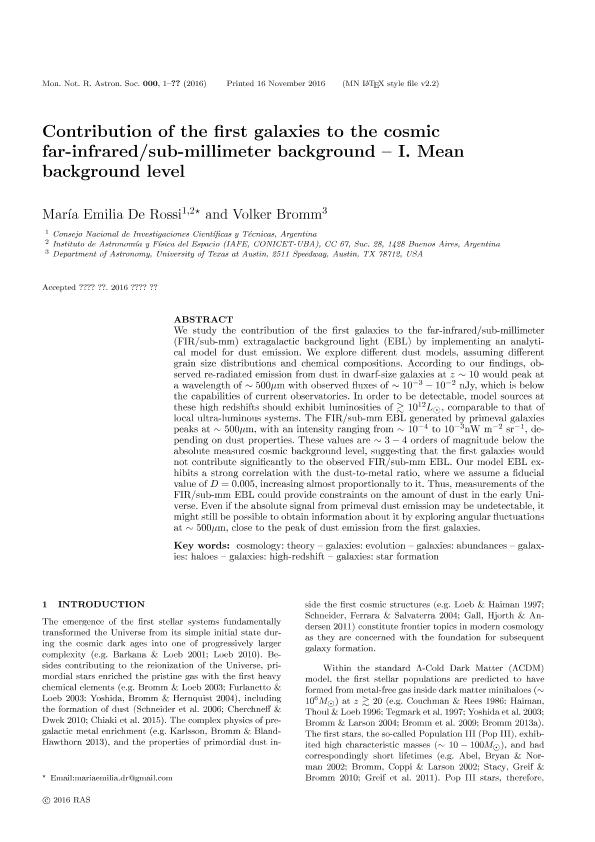Mostrar el registro sencillo del ítem
dc.contributor.author
de Rossi, Maria Emilia

dc.contributor.author
Bromm, Volker
dc.date.available
2017-06-13T19:41:08Z
dc.date.issued
2016-11
dc.identifier.citation
de Rossi, Maria Emilia; Bromm, Volker; Contribution of the first galaxies to the cosmic far-infrared/sub-millimeter background - I. Mean background level; Oxford University Press; Monthly Notices Of The Royal Astronomical Society; 465; 3; 11-2016; 3668-3679
dc.identifier.issn
0035-8711
dc.identifier.uri
http://hdl.handle.net/11336/18128
dc.description.abstract
We study the contribution of the first galaxies to the far-infrared/sub-millimeter (FIR/sub-mm) extragalactic background light (EBL) by implementing an analytical model for dust emission. We explore different dust models, assuming different grain size distributions and chemical compositions. According to our findings, observed re-radiated emission from dust in dwarf-size galaxies at z~10 would peak at a wavelength of 500μm with observed fluxes of 10^(-3)− 10^(−2) nJy, which is below the capabilities of current observatories. In order to be detectable, model sources at these high redshifts should exhibit luminosities of >10^(12) L_sun, comparable to that of local ultra-luminous systems. The FIR/sub-mm EBL generated by primeval galaxies peaks at 500μm, with an intensity ranging from 10^(−4) to 10^(−3) nW m^(−2) sr^(−1), depending on dust properties. These values are ~ 3 − 4 orders of magnitude below the absolute measured cosmic background level, suggesting that the first galaxies would not contribute significantly to the observed FIR/sub-mm EBL. Our model EBL exhibits a strong correlation with the dust-to-metal ratio, where we assume a fiducial value of D = 0.005, increasing almost proportionally to it. Thus, measurements of the FIR/sub-mm EBL could provide constraints on the amount of dust in the early Universe. Even if the absolute signal from primeval dust emission may be undetectable, it might still be possible to obtain information about it by exploring angular fluctuations at 500μm, close to the peak of dust emission from the first galaxies.
dc.format
application/pdf
dc.language.iso
eng
dc.publisher
Oxford University Press

dc.rights
info:eu-repo/semantics/openAccess
dc.rights.uri
https://creativecommons.org/licenses/by-nc-sa/2.5/ar/
dc.subject
Cosmology: Theory
dc.subject
Galaxies: Evolution
dc.subject
Galaxies: Abundances
dc.subject
Galaxies: Haloes
dc.subject
Galaxies: High-Redshift
dc.subject
Galaxies: Star Formation
dc.subject.classification
Astronomía

dc.subject.classification
Ciencias Físicas

dc.subject.classification
CIENCIAS NATURALES Y EXACTAS

dc.title
Contribution of the first galaxies to the cosmic far-infrared/sub-millimeter background - I. Mean background level
dc.type
info:eu-repo/semantics/article
dc.type
info:ar-repo/semantics/artículo
dc.type
info:eu-repo/semantics/publishedVersion
dc.date.updated
2017-06-13T14:14:39Z
dc.journal.volume
465
dc.journal.number
3
dc.journal.pagination
3668-3679
dc.journal.pais
Reino Unido

dc.journal.ciudad
Oxford
dc.description.fil
Fil: de Rossi, Maria Emilia. Consejo Nacional de Investigaciónes Científicas y Técnicas. Oficina de Coordinación Administrativa Ciudad Universitaria. Instituto de Astronomía y Física del Espacio. - Universidad de Buenos Aires. Facultad de Ciencias Exactas y Naturales. Instituto de Astronomía y Física del Espacio; Argentina
dc.description.fil
Fil: Bromm, Volker. University Of Texas At Austin; Estados Unidos
dc.journal.title
Monthly Notices Of The Royal Astronomical Society

dc.relation.alternativeid
info:eu-repo/semantics/altIdentifier/doi/http://dx.doi.org/10.1093/mnras/stw2971
dc.relation.alternativeid
info:eu-repo/semantics/altIdentifier/arxiv/https://arxiv.org/abs/1610.05407
dc.relation.alternativeid
info:eu-repo/semantics/altIdentifier/ark/https://academic.oup.com/mnras/article-abstract/465/3/3668/2544377/Contribution-of-the-first-galaxies-to-the-cosmic?redirectedFrom=fulltext
Archivos asociados
